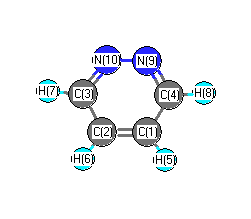Geometric Data

Point Group C2v
Internal coordinates
distances (r) in Å, angles (a) in degrees, dihedrals (d) in degrees
Cartesians
| Atom |
x (Å) |
y (Å) |
z (Å) |
| C1 |
0.0000 |
0.6875 |
1.1820 |
| C2 |
0.0000 |
-0.6875 |
1.1820 |
| C3 |
0.0000 |
-1.3213 |
-0.0618 |
| C4 |
0.0000 |
1.3213 |
-0.0618 |
| H5 |
0.0000 |
1.2243 |
2.1007 |
| H6 |
0.0000 |
-1.2243 |
2.1007 |
| H7 |
0.0000 |
-2.3759 |
-0.2026 |
| H8 |
0.0000 |
2.3759 |
-0.2026 |
| N9 |
0.0000 |
0.6650 |
-1.2313 |
| N10 |
0.0000 |
-0.6650 |
-1.2313 |
Atom - Atom Distances 
Distances in Å
| |
C1 |
C2 |
C3 |
C4 |
H5 |
H6 |
H7 |
H8 |
N9 |
N10 |
| C1 |
|
1.3750 | 2.3627 | 1.3960 | 1.0640 | 2.1211 | 3.3618 | 2.1835 | 2.4134 | 2.7665 |
| C2 |
1.3750 |
|
1.3960 | 2.3627 | 2.1211 | 1.0640 | 2.1835 | 3.3618 | 2.7665 | 2.4134 |
| C3 |
2.3627 | 1.3960 |
|
2.6425 | 3.3401 | 2.1647 | 1.0640 | 3.6999 | 2.3050 | 1.3410 |
| C4 |
1.3960 | 2.3627 | 2.6425 |
|
2.1647 | 3.3401 | 3.6999 | 1.0640 | 1.3410 | 2.3050 |
| H5 |
1.0640 | 2.1211 | 3.3401 | 2.1647 |
|
2.4486 | 4.2739 | 2.5751 | 3.3786 | 3.8303 |
| H6 |
2.1211 | 1.0640 | 2.1647 | 3.3401 | 2.4486 |
|
2.5751 | 4.2739 | 3.8303 | 3.3786 |
| H7 |
3.3618 | 2.1835 | 1.0640 | 3.6999 | 4.2739 | 2.5751 |
|
4.7518 | 3.2102 | 1.9964 |
| H8 |
2.1835 | 3.3618 | 3.6999 | 1.0640 | 2.5751 | 4.2739 | 4.7518 |
|
1.9964 | 3.2102 |
| N9 |
2.4134 | 2.7665 | 2.3050 | 1.3410 | 3.3786 | 3.8303 | 3.2102 | 1.9964 |
|
1.3300 |
| N10 |
2.7665 | 2.4134 | 1.3410 | 2.3050 | 3.8303 | 3.3786 | 1.9964 | 3.2102 | 1.3300 |
|
Calculated geometries
for C
4H
4N
2 (Pyridazine).
Experimental Bond Angles (degrees) from cartesians 
| atom1 |
atom2 |
atom3 |
angle |
|
atom1 |
atom2 |
atom3 |
angle |
| C1 |
C2 |
C3 |
117.000 |
|
C1 |
C2 |
H6 |
120.300 |
| C1 |
C4 |
H8 |
124.600 |
|
C1 |
C4 |
N9 |
123.700 |
| C2 |
C1 |
C4 |
117.000 |
|
C2 |
C1 |
H5 |
120.300 |
| C2 |
C3 |
H7 |
124.600 |
|
C2 |
C3 |
N10 |
123.700 |
| C3 |
C2 |
H6 |
122.700 |
|
C3 |
N10 |
N9 |
119.300 |
| C4 |
C1 |
H5 |
122.700 |
|
C4 |
N9 |
N10 |
119.300 |
| H7 |
C3 |
N10 |
111.700 |
|
H8 |
C4 |
N9 |
111.700 |
Bond descriptions
Examples: C-C single bond, C=C, double bond, C#C triple bond, C:C aromatic bond
| Bond Type |
Count |
| H-C |
4 |
| C:C |
3 |
| C:N |
2 |
| N:N |
1 |
Connectivity
| Atom 1 |
Atom 2 |
| C1 |
C2 |
| C1 |
C4 |
| C1 |
H5 |
| C2 |
C3 |
| C2 |
H6 |
| C3 |
H7 |
| C3 |
N10 |
| C4 |
H8 |
| C4 |
N9 |
| N9 |
N10 |










